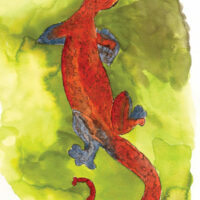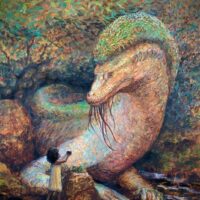Moʻo : The Guardian Lizard
Listen
At a glance
| Description | |
|---|---|
| Origin | Hawaiian Mythology |
| Classification | Spirits |
| Family Members | N/A |
| Region | Hawaii |
| Associated With | Shapeshifting, Protection, Illusion |
Mo’o
Introduction
In the heart of Hawaiian mythology, Moʻo stand as some of the most captivating and mysterious beings. These shapeshifting lizard or dragon-like spirits appear in the oldest chants and stories, bound to the islands’ freshwater pools, sacred caves, and coastal cliffs. Moʻo are far more than mythical monsters; they are guardians of resources, enforcers of sacred law, and reminders of the deep spiritual connection between people and their land. Their legends weave together themes of protection, transformation, and the consequences of respect—or disrespect—for nature’s power. In Hawaiian belief, to understand the Moʻo is to understand the delicate balance between humans, the environment, and the divine.
Physical Traits
Moʻo are described as immense creatures, often measuring anywhere from twelve to thirty feet in length. Their glossy black scales shimmer like wet volcanic rock, allowing them to blend seamlessly into the landscape. Many stories emphasize their amphibious nature, with the ability to live both in water and on land. Their eyes are often depicted as a striking yellow or green, glowing in the dark and said to be capable of mesmerizing those who meet their gaze.
Shapeshifting lies at the core of their identity. A Moʻo may appear as a gigantic lizard, a slender water serpent, or a stunningly beautiful woman whose allure hides her predatory intent. The smaller geckos of Hawaiʻi are often regarded as miniature reflections of these larger spirits, possessing similar abilities to change color and detach their tails when threatened. In human form, female Moʻo are typically portrayed as irresistibly attractive yet dangerous, their beauty serving as a lure for unsuspecting lovers.
Family
Hawaiian tradition traces all Moʻo back to a single lineage led by Moʻo Inanea, a divine chiefess or goddess of extraordinary power. According to legend, Moʻo Inanea guided her kin from the mystical Hidden Land of Kāne to Hawaiʻi, arriving alongside other gods and settling first in Waolani before dispersing throughout the islands. She is said to have assigned each Moʻo a specific location to protect, ensuring the preservation of freshwater sources and sacred places.
Some Moʻo were once mortal women of high status, often priestesses, who were transformed into guardian spirits after death. This transformation was not automatic—it required elaborate rituals, chants, and the blessing of Moʻo Inanea herself. Once accepted, these new Moʻo would reveal their sacred name to their family, allowing loved ones to call upon them for guidance or protection. Over time, however, as Hawaiian society evolved and new religious influences arrived, Moʻo began appearing in stories as antagonists, particularly in myths involving the volcano goddess Pele and her sister Hiʻiaka. In these tales, Moʻo became malevolent water spirits challenging the fiery forces of the volcano, though their role as powerful spiritual beings remained intact.
Other names
While “Moʻo” is the most widely used name, these spirits appear under various titles and classifications across the islands. Moʻo wahine specifically refers to female Moʻo, often tied to freshwater ponds or sacred groves. Akua Moʻo identifies them as divine reptilian deities, while the broader term kupua encompasses all shapeshifting supernatural beings, including Moʻo. In Hawaiian oral tradition, the term kaʻao moʻo refers to entire cycles of stories dedicated to these beings, often recounting their trials, battles, and acts of guardianship.
Moʻo also share connections with the aumākua, or ancestral guardian spirits, which can take many forms such as sharks, owls, or hawks. The lizard’s ancient presence in Polynesian storytelling underscores its enduring symbolic weight as a protector and enforcer of kapu (sacred law).
Powers and Abilities
Moʻo wield a formidable array of supernatural powers, many of which revolve around their control over water and weather. They can summon rain, command streams, and create dangerous ocean waves, including tsunamis. Their mastery of illusion allows them to disguise themselves in any form—human, animal, or elemental—while their hypnotic gaze can enchant or terrify those who meet it.
As guardians, they protect the ponds, rivers, and coastal areas under their care. A well-tended Moʻo would bless the land with clean water and abundant fish, but neglect or disrespect could bring droughts, storms, or even deadly floods. Many fishponds once had stone altars dedicated to the resident Moʻo, where offerings of ʻawa (kava) and food were made to maintain harmony.
Moʻo also serve as intermediaries between humans and the gods, especially in matters involving sorcery and sacred law. Their disembodied tongues and tails, even after separation from the body, are believed to retain spiritual potency. In creation legends, Moʻo act as defenders of families, districts, and entire islands. One notable example is King Kamehameha I’s dedication of his political unification to the Moʻo-woman Kihawahine, whose image was honored as a divine protector.
Modern Day Influence
The legacy of the Moʻo continues to shape Hawaiian identity today, both culturally and environmentally. Their stories, preserved through chants, hula, and oral histories, are now taught in schools and cultural programs as part of efforts to revive Hawaiian language and traditions. By highlighting the importance of respecting natural resources, Moʻo legends serve as a form of ecological education, urging communities to care for water sources and prevent overfishing.
In contemporary Hawaiian art, Moʻo are reimagined through paintings, carvings, tattoos, and digital media. They appear in literature and performance, sometimes as fierce dragons, other times as alluring guardians, but always as embodiments of nature’s dual beauty and danger. The work of scholars such as Marie Alohalani Brown has deepened understanding of their cultural significance, connecting Moʻo to broader concepts like kino lau, the multiple forms a deity may take, and moʻokūʻauhau, the genealogical links that bind people to land and ancestors.
Spiritual practitioners still invoke Moʻo in rituals, seeing them as ancestral guides capable of offering wisdom or protection. At certain sacred ponds and caves, visitors continue to leave offerings, honoring the kapu associated with these sites. In environmental activism, Moʻo stories inspire campaigns to protect Hawaiian waterways, emphasizing that caring for these places is not only ecological stewardship but also cultural obligation.
Ultimately, Moʻo remain living symbols of Hawaiʻi’s spiritual ecology. They embody the interconnectedness of water, land, and life, reminding all who hear their stories that the boundaries between myth and reality can be as fluid as the pools they guard. To speak of the Moʻo is to speak of the islands themselves—ever-changing, powerful, and deserving of deep respect.
Related Images
Source
Beckwith, M. (1970). Hawaiian Mythology. University of Hawaii Press.
Pukui, M. K., Haertig, E. W., & Lee, C. A. (1972). Nana i ke kumu (Vol. 1). Queen Liliʻuokalani Children’s Center.
Kanahele, G. S. (1995). Ku Kanaka—Stand Tall: A Search for Hawaiian Values. University of Hawaii Press.
Maly, K., & Maly, O. (2003). He Moʻolelo ʻĀina: Cultural Landscape Study of Kīlauea. Kamehameha Schools.
Hawaiian Encyclopedia. (n.d.). Moʻo. Retrieved from https://www.hawaiianencyclopedia.com
Bishop Museum. (n.d.). Hawaiian Legends and Oral Traditions. Retrieved from https://www.bishopmuseum.org
Frequently Asked Questions
What is lorem Ipsum?
I am text block. Click edit button to change this text. Lorem ipsum dolor sit amet, consectetur adipiscing elit. Ut elit tellus, luctus nec ullamcorper mattis, pulvinar dapibus leo.
What is lorem Ipsum?
I am text block. Click edit button to change this text. Lorem ipsum dolor sit amet, consectetur adipiscing elit. Ut elit tellus, luctus nec ullamcorper mattis, pulvinar dapibus leo.
What is lorem Ipsum?
I am text block. Click edit button to change this text. Lorem ipsum dolor sit amet, consectetur adipiscing elit. Ut elit tellus, luctus nec ullamcorper mattis, pulvinar dapibus leo.
What is lorem Ipsum?
I am text block. Click edit button to change this text. Lorem ipsum dolor sit amet, consectetur adipiscing elit. Ut elit tellus, luctus nec ullamcorper mattis, pulvinar dapibus leo.
What is lorem Ipsum?
I am text block. Click edit button to change this text. Lorem ipsum dolor sit amet, consectetur adipiscing elit. Ut elit tellus, luctus nec ullamcorper mattis, pulvinar dapibus leo.









